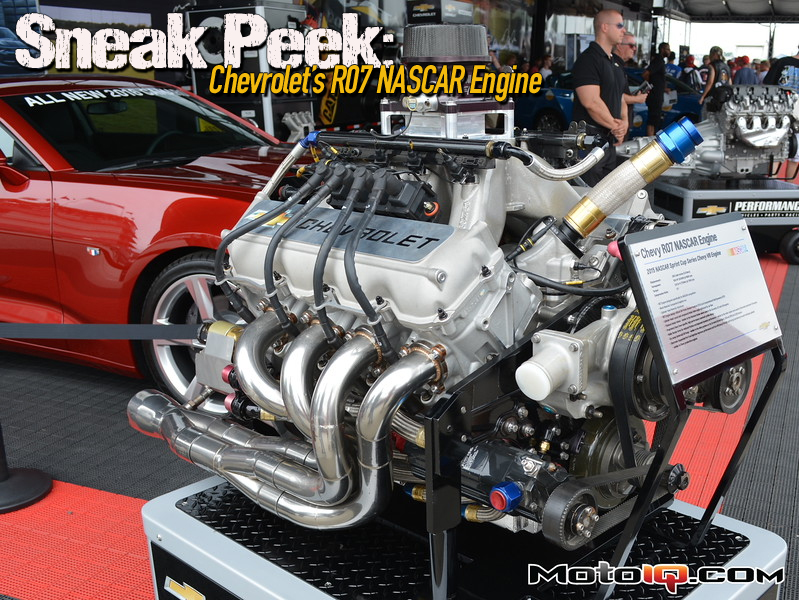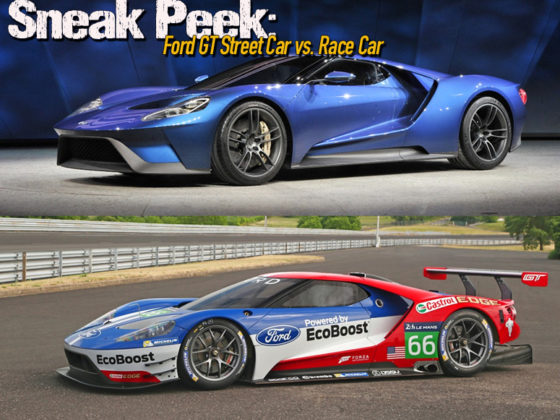Sneak Peek: A Glance At Chevrolet's NASCAR Engine
Let's preface this article with the following statement: Yes, we know MotoIQ's readership are not NASCAR fans. But when we saw this motor sitting on a stand at the Chevrolet booth, we got intrigued. It turns out while we weren't paying attention, NASCAR teams have been sneakily turning their stock cars into full blown racing monsters! Chevy's NASCAR engine is really advanced, despite being limited by NASCAR's rules. Tanner Foust and Papadakis Racing realized the potential of these NASCAR motors and slipped a TRD unit into Tanner's old and very controversial Scion tC. Unfortunately the juiciest bits were hidden away, but we learned some rather interesting things while we looked around.
 Chevy's NASCAR offering is the R07. This engine debuted in 2007, back in the days of NASCAR carburetion. In 2012, Chevy updated the engine with a new intake manifold to allow for EFI to be installed. The R07 is completely bespoke, sharing no components with the LS engine family (compared to the old SB2 engine that was still compatible with Vortec and older small blocks). Because the new engine is a racing engine from top to bottom, all oil and coolant passages can be cast directly into the block, simplifying the engine bay and reducing the number of possible leak points (internal cooling was apparently a weak point of the SB2 engines and required a number of coolant bypass lines). The block is cast iron, per NASCAR rules, while heads are aluminum. Bores are limited to 4.185″ and the displacement is 358 ci (or 5.7L to metric speaking folk). While these engines are capable of revving to 10,000 RPM, NASCAR currently limits them to around 9300 to 9600 RPM on the track.
Chevy's NASCAR offering is the R07. This engine debuted in 2007, back in the days of NASCAR carburetion. In 2012, Chevy updated the engine with a new intake manifold to allow for EFI to be installed. The R07 is completely bespoke, sharing no components with the LS engine family (compared to the old SB2 engine that was still compatible with Vortec and older small blocks). Because the new engine is a racing engine from top to bottom, all oil and coolant passages can be cast directly into the block, simplifying the engine bay and reducing the number of possible leak points (internal cooling was apparently a weak point of the SB2 engines and required a number of coolant bypass lines). The block is cast iron, per NASCAR rules, while heads are aluminum. Bores are limited to 4.185″ and the displacement is 358 ci (or 5.7L to metric speaking folk). While these engines are capable of revving to 10,000 RPM, NASCAR currently limits them to around 9300 to 9600 RPM on the track. As mentioned above, NASCAR allowed EFI in 2012 after pressure from its OEMs (though only the top tier series use EFI: lower series still use carburetors). On the the Chevy engine, fuel and air are delivered through a Holley EFI throttle body. The injection system itself is made by McLaren electronics (who also supplies spec EFI computers to IndyCar and Formula 1). By using a standardized computer, NASCAR can easily police for things like traction control (fears of traction control and electronic cheating was one reason NASCAR stayed away from EFI for so long. No computers meant no possibility of traction control). The large spacer below the throttle body is new for 2015. NASCAR mandated these to lower horsepower from 850 to 725 to help slow the cars down (a reduction in weight and downforce helps keep speeds up, while the lower power forces drivers to be extra smooth). A separate restrictor plate is still used at Daytona and Talladega to further reduce engine output.
As mentioned above, NASCAR allowed EFI in 2012 after pressure from its OEMs (though only the top tier series use EFI: lower series still use carburetors). On the the Chevy engine, fuel and air are delivered through a Holley EFI throttle body. The injection system itself is made by McLaren electronics (who also supplies spec EFI computers to IndyCar and Formula 1). By using a standardized computer, NASCAR can easily police for things like traction control (fears of traction control and electronic cheating was one reason NASCAR stayed away from EFI for so long. No computers meant no possibility of traction control). The large spacer below the throttle body is new for 2015. NASCAR mandated these to lower horsepower from 850 to 725 to help slow the cars down (a reduction in weight and downforce helps keep speeds up, while the lower power forces drivers to be extra smooth). A separate restrictor plate is still used at Daytona and Talladega to further reduce engine output. Just like their street engines, the R07 uses coil on plug ignition. Unlike typical coil on plug systems, the coils are mounted high on the intake manifold. This is done to keep them cooler. The intake runners go deep into the vee, making it as straight a shot from the throttle body into the combustion chamber as possible. This was one freedom the designers had for the R07 that they did not get from the SB series of engines before. The intake manifold has fairly long runner to improve breathing at high RPM. There are three approved manifolds for different types of tracks: one for short tracks, one for faster tracks, and one for restrictor plate races. This one would likely be for a faster track like Indianapolis or Michigan where the drivers are at full throttle for most of the lap. The fuel injectors spray directly into the combustion chambers, once again a nearly straight shot. Interestingly, the manifold is cast instead of formed sheet metal, or composites, like many racing manifolds. This is likely due to NASCAR rules. A formed metal intake would be lighter and possibly flow better, but is more expensive and does not look like it would fit on a street car (despite the fact that nothing on this engine is street legal). You can bet the inside has been carefully ported and extrude honed to extract every bit of flow possible.
Just like their street engines, the R07 uses coil on plug ignition. Unlike typical coil on plug systems, the coils are mounted high on the intake manifold. This is done to keep them cooler. The intake runners go deep into the vee, making it as straight a shot from the throttle body into the combustion chamber as possible. This was one freedom the designers had for the R07 that they did not get from the SB series of engines before. The intake manifold has fairly long runner to improve breathing at high RPM. There are three approved manifolds for different types of tracks: one for short tracks, one for faster tracks, and one for restrictor plate races. This one would likely be for a faster track like Indianapolis or Michigan where the drivers are at full throttle for most of the lap. The fuel injectors spray directly into the combustion chambers, once again a nearly straight shot. Interestingly, the manifold is cast instead of formed sheet metal, or composites, like many racing manifolds. This is likely due to NASCAR rules. A formed metal intake would be lighter and possibly flow better, but is more expensive and does not look like it would fit on a street car (despite the fact that nothing on this engine is street legal). You can bet the inside has been carefully ported and extrude honed to extract every bit of flow possible. On the right side, we can see some of the accessories. The water pump and coolant outlet is housed here. At the bottom is the dry sump oil pump. It looks to be 5 stages, just like Foust's Toyota engine. You can also see why Chevrolet mounted the ignition coils high: the spark plugs snake down next to the headers. If the coils were there, they would surely be cooked and fail. The plug placement seems odd at first until you peek under the valve covers.
On the right side, we can see some of the accessories. The water pump and coolant outlet is housed here. At the bottom is the dry sump oil pump. It looks to be 5 stages, just like Foust's Toyota engine. You can also see why Chevrolet mounted the ignition coils high: the spark plugs snake down next to the headers. If the coils were there, they would surely be cooked and fail. The plug placement seems odd at first until you peek under the valve covers.



